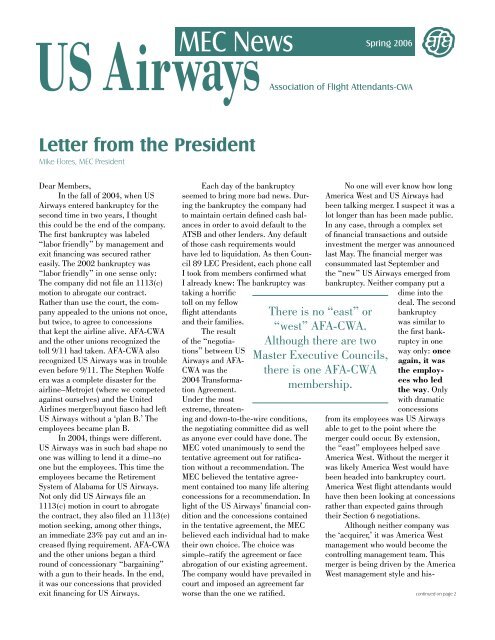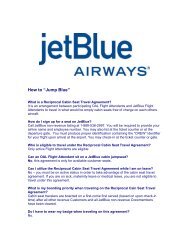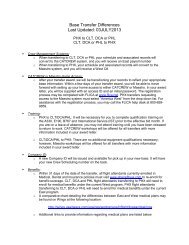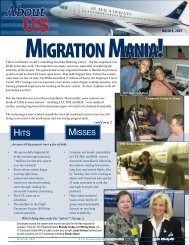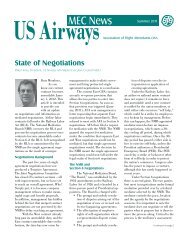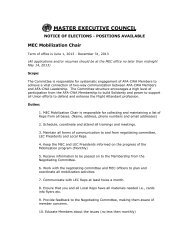Here - AFA USAirways
Here - AFA USAirways
Here - AFA USAirways
Create successful ePaper yourself
Turn your PDF publications into a flip-book with our unique Google optimized e-Paper software.
Working on Capitol Hill for US!Marianne Moore, USA East Legislative MEC ChairpersonUS Airways EAST and WESTjoined with several other membercarriers to earn frequentflier points for flight attendant issueson Capitol Hill. Our sisters and brotherswith CWA joined us in lobbyingCongress to prevent the Department ofTransportation from changing a longstandingregulation of foreign controlover the day-to-day operations of aUS carrier. Timing is everything. Withall of the discussion, pro and con, onthe United Arab Emirates, it was anincredible segue into this issue. Ifthis Notice of Proposed Rulemakingis not struck down, a foreign investor,or worse, a foreign subsidized airlineinvestor could have a direct say andpotentially controlling authority inday-to-day operations of United Statesairlines, routefrequency, originand destinationpoints, marketstrategy, hiringpractices, basecoverage levelsand a virtualgamut of operationalissues.We have enoughtrouble with ourown operationalinadequacieswithout allowingforeign controlwith conflictinginterests to enter into the havoc! Thisrulemaking would also circumvent along-standing precedent (since thedismantling of the Civil AeronauticsBoard) and take this responsibilityout of Congressional hands and intothe Administration’s oversight. Theargument is made that we need foreigninvestment to allow our airlinesto survive. We (US) are a strikingexample of how two weak US carriersfound capital investment in the goodold USA. It is interesting that most ofthe carriers themselves are againstthis foreign investment rulemaking,even those in bankruptcy. Delta andNorthwest could possibly gain accessto foreign capital at this juncture intheir bankruptcy, but choose not toand to stand up against foreign ownership.US Airways also is against thisNotice of Proposed Rulemaking. Infact, there is only one airline activelylobbying for it and that is UnitedAirlines. Stay tuned and get involved.Go to the International or US AirwaysMEC website and learn more. We urgeyou to call Members of Congress andask them to co-sponsor HR 4542 andS 2135.As many of you know, I havebeen lobbying Congress on issues thatare important to our profession formany years. Never have I seen an issueas galvanizing as Leave All BladesBehind. This legislationcame into being when,on December 22, 2006,in the midst of holidaydisarray, the TransportationSecurity Administration(TSA) AdministratorKip Hawley and Secretaryof Homeland SecurityMichael Chertoff decidedblankedly to allow scissorswith less than four inchblades and screwdriversor other tools of lessthan seven inches backon board the airplane. Inone of the offices we lobbied,the Homeland Security aide forthe Member of Congress said, “Youshould be making screwdrivers notbeing assaulted with them.” In factno one we lobbied could come upwith any reason for the rule to havechanged. The TSA argues that theirbudget for screeners has been cut andthat the available screeners need tofocus on searching for explosive devices.It is admirable that TSA wishesto focus its efforts on potential suicidebombers, but such efforts should notlead to allowing potentially dangerousitems into the aircraft cabin.It is a statistical truth that air rageincidents are higher than pre 9/11levels and the individual cases aresignificantly more disturbing. Whatwould possess a passenger to biteanother passenger and jump off anairplane while it is actively taxiing?We, the safety professionals and lastline of defense, are put in the positionof taking a step backwards andbeing exposed to dangerous items. Weknow that the cockpit door is secureand these items do not necessarilypose a threat to cockpit integrity, butdo offer a scenario for potential harmto passengers and crew alike. In thewords of an Alaska Airlines captainwho is also a Federal Flight DeckOfficer, “As an FFDO, I cannot leavethe cockpit during a threat to quelldisturbances. Federal Air Marshalsare still not on every flight to assistduring serious threats against flightattendants. Watch lists do not guardagainst mentally disturbed personson a mission. And last, no effective,federally required defense training forcrew members has been establishedto enable them to confront situationsif they arise. In summary, I prefer acabin environment in which no potentialweapons exist. I am fearful thatthe TSA just as the FAA has becomea victim of the tombstone mentalityin that it will take a fatality in thecabin caused by one of the previouslyforbidden items to change the rules.”Captain Clifton Rowe put himself onthe line to make an effort for change.We need you to be just as concernedabout your working environment.Let your Members of Congressknow that they are personally lettingyou down if they do not co-sponsorS 2083/HR 4452 “Leave All BladesBehind.” We have the support of theFamilies of September 11, the CEO ofboth Alaska Airlines and Horizon Air,the Transportation Trades Departmentof the AFL-CIO and the Federal Lawcontinued on page 54 www.afausairways.org
Capitol Hill, from page 4Enforcement Officers Association.Shouldn’t we have the support of yourMembers of Congress as well?(At the time of this writing CEODoug Parker has been given a resolutionby our MEC supporting LeaveAll Blades behind but he has notresponded.)USA Legislative Representatives, left to right:Steve Schembs, Liz Haransky, Alin Boswell.A True US Airways <strong>AFA</strong>-CWA HeroI wish that all of our memberscould share some of the great momentsI have had the privilege ofhaving by being your Legislative Representative.One that clearly comesto mind is when Rep. Jim Oberstar(D-MN) spoke as committee chairmanduring the hearings on the smokingban and called it shameful thatflight attendants were being treatedlike canaries in the mines by workingin a smoke filled cabin. Anotherwas when Congressman Nick Rahall(D-WV) said that aviation employees’loss of benefits, medical coverage andpensions was un-American and a verysad day in the history of this country.Another such moment was this Marchwhen Congressman Rob Simmons (R-CT) addressed the representatives ofthe Legislative conference. CongressmanSimmons has spent over 40 yearsin public service to his country withtime spent in the Connecticut GeneralAssembly. He enlisted in the Army asa Private and graduated from OfficersCandidate School. Congressman Simmonshas served on the Senate IntelligenceCommittee for Sen. Chafee,worked with the CIA, as a US ArmyReserve Intelligence Officer and inVietnam. He related to us his personalfeelings when he was shot down twicein Vietnam and interfaced how we, assafety professionals, go to work everyday prepared to take on the task ofour passengers’ survival in an aircraftincident. I was in the front row andsaw his copy of the 9/11 Commissionreport. It was well worn and dogeared.He told us of his awe that BettyOng dealt with the situation on boardthe airplane knowing that a first classpassenger had already had his throatslit. His own constituent, flight attendantMadeline Amy Sweeney,maintained perfect composurein tending to her passengers,all the while knowing of theirfate and hers while she keptthe ground notified as to everyaction on the plane. “We areway too low, oh my God, weare way to low,” she said justbefore flight 11 hit the WorldTrade Center. Her actions keptthe ground notified and helpedkeep flight 93 from hitting itsmark. Congressman Simmonswas quite emotional when hesaid we should have a statueto those flight attendants that continuedto do their jobs and comfort theirpassengers on this most tragic day.Congressman Rob Simmons hasbeen a long-standing friend of <strong>AFA</strong>-CWA over his three terms in Congress.He recommended funds for athorough flight attendant fatigue studyover the objections of his leadershipbecause, in his words, it was quitesimply the right thing to do. He wenton to say that America is Airborne!Our economy relies on safe transportationto do business. No US airlineshould be controlled by foreigners.Neither our ports nor our airlines arefor sale, nor is America for sale.So when you are flying a trip andyour manifest tells you that CongressmanSimmons is on board, pleasethank him for all he does for us. Youmight notice him as the one with thedog-eared copy of the 9/11 CommissionReport or the Leave All BladesBehind Sticker on his briefcase.Flight Attendants Are Generousby NatureMany flight attendants volunteerwith worthwhile organizations toonumerous to name. If there were anorganization that:• Promoted the limitation of carryonbaggage• Fought for cabin air quality• Continued efforts to includeflight attendants under OSHA• Compelled the government not to‘outsource’ flight attendant jobs• Provided documentation thatuse of cell phones on board anaircraft is a bad thing• Maintained a decades-longpresence on Capitol Hill earninga reputation among powerfulMembers of Congress as thepre-eminent voice for flight attendantissues• Trained its members to lobbyMembers of Congress with professionalismand respect• Held lobbying events targetingcurrent issues of concern to itsmembers• Supported Members of Congresssuch as Congressman Rob Simmonsto keep him in CongressWouldn’t you want to be a memberof that volunteer group?You can be! All efforts of the<strong>AFA</strong>-CWA in the political arena arefunded by voluntary contributionsfrom members like you to FlightPAC.It is through your generosity and supportthat we carry the torch on CapitolHill. Without you, our voices would besilent.Out of courtesy we tip our vandrivers for putting our luggage in thevan. Imagine if every flight attendantcontributed four van tips a month toFlightPAC. You would certainly getyour money’s worth. Unfortunately,membership participation has not keptpace with the unprecedented growthof our issues in Congress. There are somany competing interests for our hardearned dollars, but I ask that you considercontributing a few dollars to ourindependent legislative arm to allowus to keep the skies safer for you.www.afausairways.org 5
FMLA/PCLPaul H. Frishkorn, <strong>AFA</strong>-CWA Benefits Chairperson1. What is PCL/FMLA?FMLA stands for Family MedicalLeave Act and is a federal law.Personal Care Leave (PCL) is acontractual provision in Section 20,“LEAVES OF ABSENCE”, in ourflight attendant agreement.2. Who Qualifies for FMAL/PCL?Flight attendants qualify forFMLA or PCL depending on either theFMLA statute or contractual provisions.For FMLA, the employee has tohave been employed by the employerfor at least 12 months and accumulatedat least 1,250 “Duty Hours” duringthe 12-month period immediatelypreceding the commencement of theleave. For PCL, the flight attendantmust have accumulated 450 hoursof “Credited Time.” In many waysPCL was designed to mirror FMLA.Eligible flight attendants shall beafforded the equivalent leave benefitsof FMLA. There are two major differencesbetween the two that determinewhich leave a flight attendant is entitledto and how the leave is applied.3. What is the differencebetween “Duty Hours” andCredited Time”?“Duty hours” as defined byFMLA is time spent on duty each day.For our purposes it is the time fromcheck-in to check-out for each dutyperiod. Total Time Away From Baseis not counted. This was determinedwhen the law was first written and anexemption was sought and denied forairline employees. The 1250 hourduty time threshold is, in many cases,unattainable for flight attendants.PCL is based on “Credited Hours”as defined in our contract. “CreditedHours” includes all flight time, deadheadtime, vacation, sick leave credit,all variable minimum, duty rigs, triphour credit, company or union businesscredit, salary continuance credit,jury duty credit and reserve minimumguarantee credit. In short, FMLAreflects time spent on duty for eachduty period and PCL reflects actualcredited pay.4. How much time may I takeoff?You are eligible for up to 12weeks per year. Under FMLA, thetime may be taken daily or in blocksof time up to the full 12 weeks. ForPCL, the time must be taken in eitherfive consecutive days or in blocks oftime up to the allowable 12 weeks.5. Under what circumstancesare employers required to grantFMLA/PCL?1. The birth of and care of a child.2. The placement with the employeeof a child for adoption orfoster care.3. To care for the employee’sspouse, child or parent with aserious health condition.4. Due to a serious health conditionthat makes the employeeunable to perform the functionsof the employee’s job.(Please note that under FLMA/PCL,a father as well as a mother can takefamily leave for the birth, placementfor adoption or foster care of a child.)A husband and wife who areemployed by the same employer arelimited to a combined 12 weeks leaveduring a 12 month period for the birthof a child, adoption of a child, fosterplacement of a child or the care ofthe employee’s parent with a serioushealth condition.6. What is a serious healthcondition?A. Inpatient Care in a hospital,hospice or residential medicalcare facility.B. Continuing treatment by a healthcare provider that results in:i. A period of incapacity.ii. Any period of incapacity dueto pregnancy or prenatal careiii. Chronic serious health conditioniv. A period of incapacity whichis permanent or long-termdue to a condition for whichtreatment may not be effective(e.g. Alzheimer’s, severestroke)v. Any period of absence requiringmultiple treatments(i.e. chemotherapy, physicaltherapy, dialysis)Please note: Bed-rest, drinkingfluids, taking over-the-counter medicationsdo not qualify for a serioushealth condition.If you have any questionspertaining to rights under FMLA/PCL please contact your local unionrepresentatives or the MEC BenefitsChairperson.<strong>AFA</strong>-CWA MEC UniformCommittee UpdateBrian K Morgan, <strong>AFA</strong>-CWA MEC Uniform Co-Chair, BMorgan@afausairways.orgRecently pictures were placedon the HUB and Compassnetworks displaying proposeduniform styles. Do to the poor qualityof the photos and the mixed responsereceived, the steering committeedecided to remove the photos andre-group. A conference call was heldin February with all of the members ofthe uniform steering committee and itwas decided to ‘start over.’The committee will be approach-continued on page 76 www.afausairways.org
Draw the Lines to Fight the AttacksKeeping Your PC CleanChuck Cannaday, <strong>AFA</strong>-CWA US Airways Communications ChairIf I could show you an easy way toconvert flight pay from minutes todecimals, would you read on? If Icould show you how to use your sicktime to its fullest, would I bend yourear? If the possibility exists to learnmore about maintaining your healthin the kind of atmosphere in whichwe work, would you not put this downuntil you had read it all?I’m afraid I am not qualified tohelp you with many of these topics,but I can help you make your PC safe,and for that, you should put into practicewhat I have outlined below.The main issue is no longer thatof viruses that destroy your hard drivecausing you to re-install your operatingsystem, or worrying about losing adocument that is corrupted. Now, it’sa matter of stopping the hackers andcrackers from using your computerwithout your knowledge to do theirdirty work.There is only one way to makeyour PC safe 100% of the time andthat is to turn it off and never use it–noviruses, no worms, no pop-ups, and notone single ‘evil-doer’ to take control ofyour PC. If this sounds like an escapistmentality, maybe it is. On the otherhand, I ask you this: Where would anyof us be if we just quit when someonesaid, “If you don’t like this job...” Youget the picture. I am here to help.We all know of someone who hashad a bad experience with a virus...the one that kept rebooting the PC orthe one that played ‘keep away’ withhis or her mouse. The real seriousones wiped your hard drive clean.These viruses are still around andmost of us are protected. But now wehave a new breed of virus that incorporatesmore than one virus in it’sprogramming—six or seven virusesfor a start. And most of the viruses arenot there to do your PC any real harm;they are there to give a hacker accessto your computer for the purpose ofattacking companies, businesses, orindividuals in numbers never seen before.Once a hacker (evil-doer) gainsaccess to your PC, not only can theysee what you have on your computer,but if you have a high speed connectionor any good dial-up connection,they will use it to send out multipleemails to all email addresses in youraddress book or any email addresson your PC. These emails will floodother email accounts throughout theInternet with the hacker’s agenda or,worse, you could be one of many PCsused in a ‘Denial of Service (DOS)’attack against a corporation, business,government or individual. The hackerwill gain control of many PCs and usethose PCs to attack in force. And, thePC that will be tracked when the attackis discovered, NOT the hacker’s.Your PC will be the one that will betracked down and shut down.Got the picture? Like goodhygiene and good study habits, goodcomputing needs to be practicedalways! REMEMBER: Just becauseyour new PC came with an antivirusprogram doesn’t mean you are safe.You must subscribe to be updated withthe new virus patterns available fromyour virus company because hundredsof viruses are written each month.Now let’s lead the horse to water.First of all, if you are not running anantivirus program, or you are but youare not keeping it up to date, pleasego to one of the free sites throughoutthe Internet which will run an antiviruscheck on your PC or subscribe toyour virus program’s updating.<strong>Here</strong> is a brief list of free onlinevirus scans:http://housecall.antivirus.comcontinued on page 8Uniform Committee, from page 6ing this in a three-step process. First,marketing has decided to approachretail vendors (i.e. Nordstrom, BananaRepublic, etc.) to put together off-therackitems that can be replicated bya uniform vendor. Second, a designer(yet to be selected) will put together adesign concept that would be replicatedby a uniform vendor. And third, thedesign team will once again attempt topull items together via selected uniformvendors. All designs will maintainthe company mantra of “CorporateCasual.” An official statement will bereleased soon by corporate definingthe official and last word on “CorporateCasual.” As the design processreaches certain goals the steeringcommittee will meet to review the designsand add our comments/concerns.Changes will be made and we willreconvene at the next goal mark. Onceeach design receives the final stampof approval, the company will releasephotos on the HUB and Compass forreview and response from the employees.The photos to be placed on therespective employee websites will betaken by a professional photographer,models will be used, and the itemswill be tailored to ensure proper fit.A change of hands has occurredduring the decision to start over. ThePurchasing Department, lead byDion Flannery who was heading thesteering committee, has been movedto a supporting role and the MarketingDepartment, being lead by KarynMcAlphin and Kevin Jackson, hasofficially taken the lead.Continue to get the latest informationand rumor control via “Fromthe Hanger.” Candi and I would likethank all of you for your hard workand your support.www.afausairways.org 7
From Your Safety, Health & Security CommitteeScott Parks and Nancy Gilmer with input from the Local Safety Committees2006 Observation Ride ProgramThe 2006 Observation RideProgram (ORP) kicks into gear laterthis month. In 2003 US Airways InflightPolicy & Procedures asked ourFAA Cabin Safety Inspector and the<strong>AFA</strong>-CWA Safety, Health & SecurityCommittee to participate in the developmentof the program.Observation rides are non-punitiveand are anonymously conductedby line flight attendants to monitorflight attendant compliance with FARsand FAA-approved safety procedures.The riders observe procedures duringboarding, departure, in-flight, andarrival. For example, are all flightattendants strapped into their jumpseatsduring ground movement, unlessperforming safety-related duties?Overall, data collected duringthe rides reveals a high level ofcompliance; however, there are acouple of areas in which we need tobe more vigilant in adhering to FARs.continued on page 9Draw the Lines, from page 7(Trend Micro; can also be accessedfrom the www.afausairways.org website)http://www.symantec.com/cgi-bin/securitycheck.cgi (Symantec– Norton)http://www.kaspersky.com/remoteviruschk.html(Kaspersky Virus Labs)There are other websites that offerfree online scans as well. Positiveindications of a virus should set offthe old wake-up alarm.You should also run one of theanti-spyware programs, as these willdetect a broader range of scumware/malware, such as browser hijacks,pop-ups and auto dialer programs. Irecommend AD-Aware from Lavasofthttp://www.lavasoftusa.com (free), butthere are others that will do the trick,like Spybot, PestPatrol, and more.Just when you think you aredone, you are not. You will needto download and install a personalfirewall. If your virus program camewith one, turn it on and use it! Thepersonal firewall program, which runson your PC, will keep unwanted, evildoersfrom gaining access to your PCfrom the outside. The hacker/crackerscannot disguise the fact that they willbe using your PC to send traffic onyour Internet connection. In this case,the traffic will actually be leaving yourPC as it travels to the Internet. Whatyou need to do is install the personalfirewall and then watch the pop-upswhich notify you when programs attemptto go out. Trying to decipher theprograms that will attempt to accessthe Internet is not always easy. Thereare quite a few typical Windowsprograms, which make normal outboundconnections, including InternetExplorer, Outlook Express, svchost.exe, and others. Of course, you willhave to be aware of your applications,which will also attempt to access theInternet. Your antivirus program, especiallythe “auto-updating” feature,and your instant messenger program,will be among some of the programsthat will ask for permission to accessthe Internet. <strong>Here</strong> is list of most of thevalid XP Windows programs (some orall may want access legitimately):services.exesvchost.exeimapi.execisvc.exemsdtc.exealg.execlipsvc.exedllhost.exefxssvc.exelsass.exedmadmin.exemqsvc.exemqtgsvc.exemnmsrvc.exenetdde.exesmlogsvc.exespoolsv.exersvp.exesessmgr.exelocator.exetcpsvcs.exeSCCCardSvr.exesnmp.exesnmptrap.exeups.exevssvc.exemsiexec.exewmiapsrv.exemsimn.exe (OE)iexplore.exe (IE).Hackers will try to installprograms with names similar to validprograms. Read the firewall program’shelp files to better understand the firewallprogram. One of the best softwarefirewalls that can be installed on yourPC continues to be ZoneAlarm, whichcan be downloaded free from www.zonelabs.com. Zone Labs are makingit more and more difficult to find thefree version - you have to search, andclick through about 6 or 7 screens.Although the professional versions areprobably worth paying for if your PCis connected directly to the Internet.If you are interested in testingyour system for vulnerabilities, visitthis Website for some online scannersthat will conduct various tests on yourcomputer: http://www.computercops.biz/link-12.htmlThis all may be very overwhelmingbut, if you take it step by step,read the help sections, and readmefiles, you should be able to understandthe importance of protecting your PCand remaining vigilant. Use the supportsites, FAQs and knowledgeabletechs to assist you. Read your ISPsupport files for more information onhow your provider can help. Or, dropme a line and I will assist you if I can.webmaster@afausairways.orgThere is a wealth of informationon the Internet. Not the least of whichis the knowledge of the problems thatcan arise from ‘unsafe computers’.This quote is by Alan Paller, directorof the SANS Institute: “There’s noeasy fix for preventing DOS (Denialof Service) attacks, and the time isfast approaching when ISPs (Internetservice providers) are not going to allowusers on the Internet if they posea threat to the other users by not meetinga minimum standard of security...”– Read more at www.idg.netKnow Your Virus...and KeepYour PC Clean8 www.afausairways.org
Dealing with Difficult PeopleDeborah McCormick, USA MEC EAP, dmccormick@afausairways.orgEveryone comes up againstdifficult people, demandingsituations, anddisappointing circumstancesin every areaof life: work, marriage,relationships,and friendships. Wejust can’t avoid it. Butwe can do somethingabout it. And guesswhat, we don’t haveto quit our jobs, divorce our mates, ormove out of our neighborhoods just tofind relief.What does it take to face anddeal with difficult people? It takes awillingness to:EAPmembers helping members1. Make the most of differencesEach of us usually attractspeople who are opposites. The leaderenjoys being friends with a personwho is peaceful and dependable. Theserious, thoughtful person likes stimulationthat a playful, outgoing personprovides. The strong personality wantsthings done now and doesn’t understandwhy she/he can’t have her/hisway immediately. The reflective personwants to think things through and lookat all odds before making a decision.If we look at all these differences asgifts instead of difficulties, we canmake the most of them.2. Trust that theother person wantsharmonyIf you approacha difficult person withthe concept that theyare as eager as you areto restore harmony, youcan make the first move,knowing the result will be somethingthat you both want. Consider includingthese phrases in your conversations:“I’m sorry for what I’ve done to hurtyou” and “I could be wrong.” Neitherof those statements diminishes yourcharacter. It simply gives you theopportunity to open the dialogue doorand come to an agreement about whatto do next.3. Be aware that conversationdoesn’t have to beconfrontationalFor years, I always thought thatI had to confront anyone with whomI had a disagreement. I didn’t. All Ineeded to do was to ask to talk aboutthings, and I would vow to listen. Ican’t believe the difference that thisadjustment has made in my relationships.In one situation, I asked if wecould meet at a local coffee shop, forI missed our relationship and reallywanted to clear the air on our misunderstandings.Another time, I satdown, wrote a letter to the person thatI felt uneasy with. I said that I reallymissed our relationship and reallywanted to clear the air. Although wemay never be ‘best friends’ we arenow civil to each other without the ongoingtension.4. Learn from others and theywill learn from youRemain open to other individuals’points of view and ideas. Shareyours. Find something with that personthat you value, and then commenton it. When people feel appreciatedand supported they will be drawn toyou naturally, regardless of your differences.Who knows, you might finda new friend in the person you onceperceived as challenging.If you are faced with a challengingsituation or a difficult individualand feel you might need some assistanceto help you sort through youroptions, please call your local <strong>AFA</strong>-CWA EAP committee or the International<strong>AFA</strong>-CWA EAP Helpline at1-800-424-2406.Safety, Health & Security, from page 8When the seat belt sign is illuminated,we need to be sure to perform awalk-through of the cabin to check onpassenger compliance. In addition, weneed to be certain the correct numberof required flight attendants are onboard during boarding and deplaningat origination, through stops andtermination. Areas that need attentionsuch as these are emphasized inRecurrent Emergency Training.At the conclusion of the flight,the observation rider will identify her/himself and ask if you have time for ashort post-flight debriefing. If you do,she/he will provide positive feedbackon adherence to safety procedures andgently point out noncompliance withFARs and safety procedures.Inflight East-West Integration ofInflight Procedures/ManualUS Airways expects to operateunder one FAA certificate by May2007. US-East and US-West Inflightmanagement teams have been analyzingand developing “best practice”procedures and the ultimate goal isa smooth transition for both groupsand one Flight Attendant EmergencyManual for all US Airways flight attendants.This will be a monumentalachievement, as procedures, actions,announcements, and emergencyequipment locations vary at eachairline. We all know how important itis to provide our passengers with thesame consistent and quality producteach time they fly with us.The Inflight Integration Teamconsists of US-East and US-Westmanagement, the FAA offices governingboth carrier certificates, and<strong>AFA</strong>-CWA Safety, Health & Securitycommittee members from each car-continued on page 10www.afausairways.org 9
The Air Up ThereChristopher Witkowski, Director of Air Safety, Health & Security DepartmentEver smelled dirty socks on aflight? Most people look aroundto see who took their shoes offor has not bathed recently. Flight attendantsneed to know that this smellalso can indicate a toxic soup ofheated oil that enters the cabin airthrough the aircraft air supply system.Hydraulic fluid can also contaminatethe air supply system and has an odorof its own. Depending on the conditions,there may be no warning smelland no mist. The aircraft air supplygets contaminated relatively infrequently,but when it does, it can makesome people get very sick andstay sick.During and after a flight,crewmembers have reported irritatedor burning eyes and throat, severeheadache, dizziness, disorientation,breathing difficulties, stomach cramping,and nausea. During the weeksthat follow an exposure, some peopledevelop even more serious symptomslike long-lasting memory and balanceproblems, fatigue, tremors, andtingling or weakness. These chronicsymptoms are consistent with exposureto chemicals called TCPs. TCPsare an ingredient in all engine oilsand some hydraulic fluids. Becausethese chronic symptoms can takeweeks to develop, it can be difficult toprove that the aircraft is to blame.Although some aircraft designsare more prone to air supply contaminationair than others, the majority ofthese events likely result from inadequateor improper maintenance. Forexample, oil can enter the air supplyif an oil seal leaks or if a maintenanceworker overfills the oil reservoir. Asa result, the aircraft maintenancerecords are an important source ofinformation for proving exposure inthe workers’ compensation system.There is no air sampling on board,so maintenance records are often theonly hard evidence that somethingwas wrong. <strong>AFA</strong>-CWA internationalcan help you to obtain these records(see contact information at the end ofthis article).If you smell something suspiciousduring a flight, put a wet clothover your mouth and nose. Also makesure you see a doctor and tell thatdoctor that you may have been exposedto engine oil or hydraulic fluid.Don’t just assume that you will feelmuch better in a few days. Your symptomscan persist unexpectedly long ormore serious symptoms can flare up ifyou are exposed again.Be sure to file a report with<strong>USAirways</strong> right away and send acopy to your local <strong>AFA</strong>-CWA safetychair. Your safety chair will also giveyou a package of information that willhelp you and your doctors. Keep aSafety, Health & Security, from page 9rier. Therefore, if you have specificquestions about the integration process,please contact your Local SafetyCommittee.As new and modified proceduresare introduced to each flight attendantgroup, US-East Observation Rides,the US-West peer-to-peer version ofthe ORP, and gate checks by supervisorswill support and validate theintegration process.Inadvertent Slide DeploymentsHow do we prevent ISDs? Onemethod is to ensure that your flightattendant crew conducts a thoroughPreflight Briefing. As we all know,the briefing sets the tone for the trip,maximizes crew communication,and ensures that specific checks andbalances are in place, i.e., reviewdoor operation to be sure everyoneunderstands arming/disarming andcross-check procedures, will the Bflight attendant walk through aftereach flight to check doors and verifythrough-count, and who will visuallyscreen the exit rows?journal of any symptoms that developand take photos of any visible symptomslike rash or swelling. If you staysick, this type of documentation willbe critical.Dirty socks may just be dirtysocks but flight attendants especiallyneed to be aware of the alternativeexplanation. <strong>AFA</strong>-CWA is here to advocatefor you and is working hard tomake air supply contamination a thingof the past.More detailed information isavailable from our internationaloffice Air Safety, Health, and SecurityDepartment (http://ashsd.afacwa.org, phone: 206-932-6237,murawski<strong>AFA</strong>@earthlink.net)Following a Critical IncidentYour Safety Committee is not alwaysimmediately aware of critical incidentson the line. If you are involvedin a decompression, passenger death,cabin prep, or any serious incident,please have crew scheduling contactyour <strong>AFA</strong>-CWA Safety Committee.Critical Incident Response cards(available at your base) should beworn with your company ID. There areseveral contact numbers on the card,such as the MEC Safety Chairperson’snumber – 301-912-1223 (which willgive you her cell phone number if sheis not in the office).Cabin Safety and DisruptivePassenger Incident ReportsThese reports are to be faxedto Corporate Safety (number is onthe form) and the original co-mailed.Make a copy for yourself and eitherleave one for your <strong>AFA</strong>-CWA SafetyCommittee or contact them.If your <strong>AFA</strong>-CWA Safety Committeedoesn’t know about the incident,we can’t support you and yoursafety, health, and security concerns!10 www.afausairways.org
Scheduled Adjustment Period (SAP) Min & MaxWindow vs. Primary Line ObligationCarol Austin MEC Scheduling ChairpersonThe SAP window for June andJuly (as posted) is a maximumof 90 with a minimum of 60,unless the flight attendant is grandfatheredon the new 100/105 high option.The intent of the SAP window isto assist a flight attendant in rearranginghis/her primary line within certainboundaries. However, the ScheduleAdjustment Period does NOT allowdropping trips to the minimum of, inthis case, 60 without a potential consequence.The credited time a flight attendantowes the company each monthis either the value (pay and credit) ofhis/her primary line, or post SAP linewhichever is greater but in no casean amount greater than the monthlymaximum as declared by the Directorof Crew Scheduling, Michael Finn.One BIG misconception is thattime dropped via SAP does not haveto be made-up. Therefore, review example(1) that reflects when droppedtime must be made-up. Example (1):Karen receives primary line 6201for June worth pay and credit of 80hours. She is NOT over-projected anddecides to participate in SAP. Her onlysuccessful (awarded) unit dropped atrip worth 15 hours and resulted ina post SAP line value of 65 hours.Does Karen have the ability to dropsuch a trip and exit SAP with only65 hours? Absolutely! However, withsuch flexibility comes the obligation toincrease the 65 hours back to at least80 hours of credited company time.Why? Because the contract (see page9-9 line 4 thru 18) requires Karen tocome-in with the value of her primaryline (pay and credit) or her post SAPvalue whichever is greater. Further,the 15 hours Karen owes the companycannot be made-up via ETB. Karenwill be able to see that she owes thecompany time by looking in Option 2.Karen’s Option 2 will show PRJat 65:00, OBL at 80:00, and MAX at90:00. In the upper right hand cornerof the Option 2 screen (third line,between CLS and OBL), she will seethe code UND with a negative numbernext to it. To Karen, that means she isshort that amount of time in meetingher obligation. For example, in theUND field, she will see 15:00 — thatmeans that on the date she is lookingat Option 2, she is currently fifteenhours short of the time needed to meether obligation for the bid month ofJune. Remember, picking up time viathe ETB will not help Karen fulfillthe UND 15:00 she owes in companytime. The only way to correct the UNDissue is to pick up time via the AILor by trading trips with another flightattendant through crew schedulingwhereby time is added.Over-projection due to vacationand/or carry-over time is a reasondropped time may not result in havingto be made up. Therefore, pleasereview example (2): John receivesprimary line 2901 for June worth 80hours. It consists of all 4 days’ tripseach worth 20 hours. The trips originateon the 8th, 15th, 21st and 28th.Additionally, he has vacation from the1st through the 7th for 28 hours ofcredited time. John decides to participatein SAP. The screen, (Option 37)shows his projected pay for the monthat 108+00. In unit #1, he drops thetrip on the 8th. John knows the dropis legal and it would bring him to 88hours. Unit #2 consists of a DROPon the 15th of 20 hours and an ADDon 18th of a trip worth 15 hours. Bothunits are awarded and his post SAPline value is 83+00 credited hours(80 + 28 vac = 108 –20 drop = 88– 20 drop = 68 + 15 add = 83). Percontract, he must come-in with thevalue of his primary line (pay andcredit) or his post SAP value whicheveris greater. John will be able to reviewhis post SAP totals by looking inOption 2 which reflect PRJ at 83:00,OBL at 83:00, and MAX at 90:00.Note: The aforementionedexamples are absent any ETB activityin order to illustrate the prevailingmonthly obligations before the ETB isutilized. Now, let’s say that after SAP,in example (2), John posts the trip onthe 28th (worth 20 hours) on the ETBto be dropped. As luck would have it,the trip is picked up by Karen, fromexample (1). As a result of Karentaking the trip on the 28th John’s postSAP value of 83 hours is reducedto 63 hours and that is all he has tocome in with for June. After the aforementionedtransaction, 20 hours is“deducted” from his projection, obligationand maximum columns. John’sOption 2 would show PRJ at 63:00,OBL at 63:00 and MAX at 70:00.On the other hand, Karen fromexample (1) who picked up the 20hours is now projected at 85 hoursBUT still owes the company for thetime is she dropped via SAP. In otherwords, the 20 hours from the ETBdid not pay back the 15 hours shepreviously owed the company. Afterthe aforementioned transaction, 20hours is “added” to her projection,obligation and maximum columns.Karen’s Option 2 would show PRJ at85:00, OBL at 100:00 and MAX at110:00 plus the UND 15:00 – wouldbe reflected.High Block andLow Block Letters:High-Low Non DisciplineRange: <strong>AFA</strong>-CWA and the companyagreed that a flight attendant will bepermitted to come in with his/herprojection at the end of month up to 2hours under his/her obligation or up to3 hours over his/her maximum (in additionto the under-scheduled flying).This window has been established tocreate greater flexibility for the flightattendant when meeting their monthlycontinued on page 12www.afausairways.org 11
SAP, from page 11maximum and/or obligation. The high– low flex range will be administeredas follows:Not Too Low: Pat’s OBL is 80:00.She comes in with 78:00 P&C;therefore her name would not be listedamong those failing to meet theirobligation.Too Low: Joe’s OBL is 80:00. Heends the bid month with 77:59 P&C;therefore, the computer programwould flag him for not meeting hisobligation.Not Too High: Pam’s MAX is 90:00.She comes in with 93:00 P&C; there-fore, her name would not be listedamong those exceeding their obligation.Too High: Sal’s MAX is 90:00. Heends the bid month with 93:01 P&C;therefore, the computer programwould flag him for exceeding hisobligation.Not Too High Because of Under-Scheduled Time: Mike’s OBL is90:00 for the bid month and the MAXin the base is 90:00. He accumulates2:30 hours of under-scheduled flying;therefore, he can come in with92:30 hours by way of past practice(90 +2:30 = 92:30). Mike actuallycomes in with 95:00 pay andcredit. In this case, Mike would not beflagged among those exceeding theirobligation because of the 2:30 hoursof under-scheduled flying. Mike’slimit would be 92:30 plus the 3 hourshigh non-discipline range; therefore,95:00 would bring him under theradar.Exception: The minimum thresholdfor a flight attendant’s flying obligationis fifty hours (50:00); therefore, theunder 2 hours does not apply. Ann’sOBL is 50:00 and she ends the bidmonth with 48:00 pay and credit. Thecomputer program would flag Ann fornot meeting her obligation. RememberScheduling will not split a pairingwhen a flight attendant trying to reachthe minimum of fifty (50) hours.Association of Flight Attendants-CWA, AFL-CIO501 Third Street, NWWashington, DC 20001www.afanet.org


